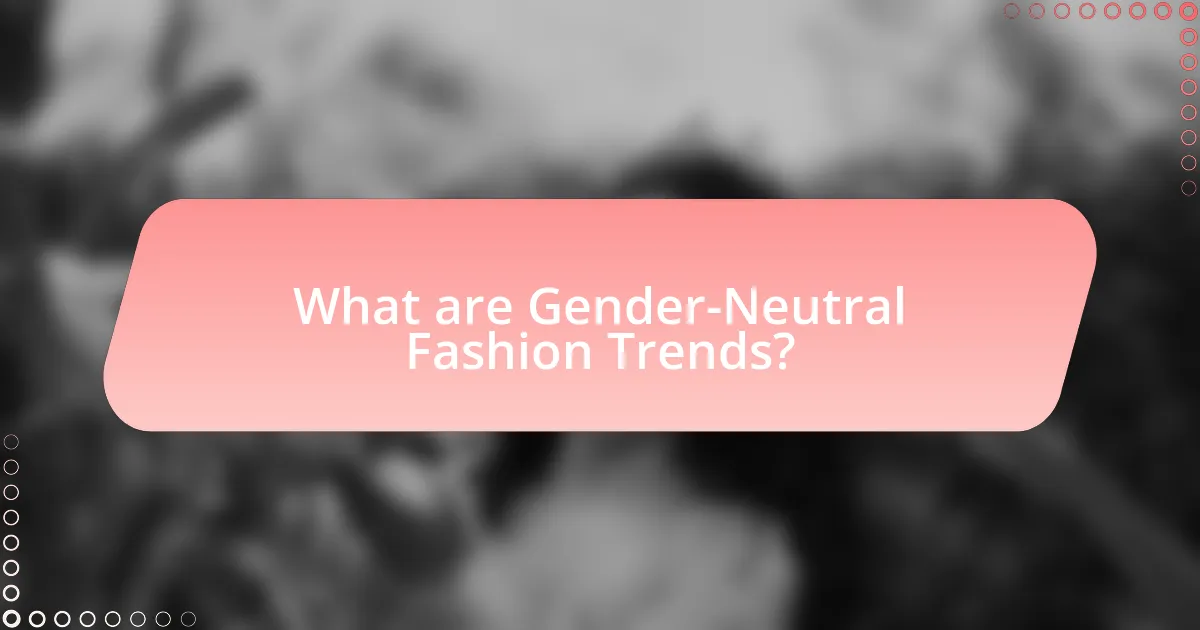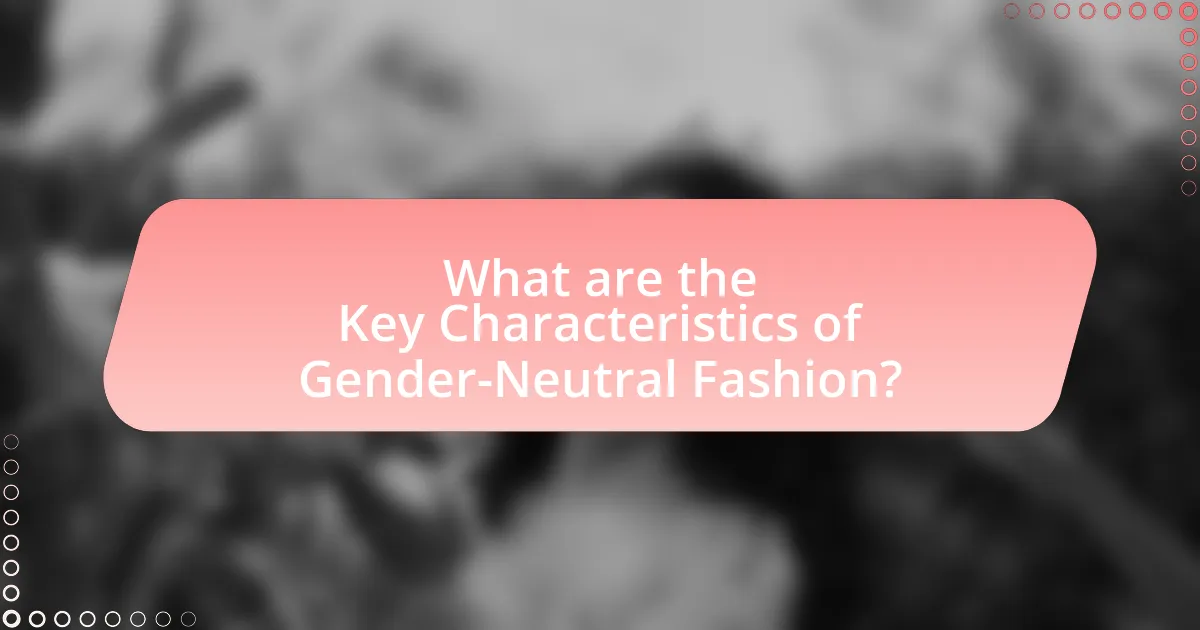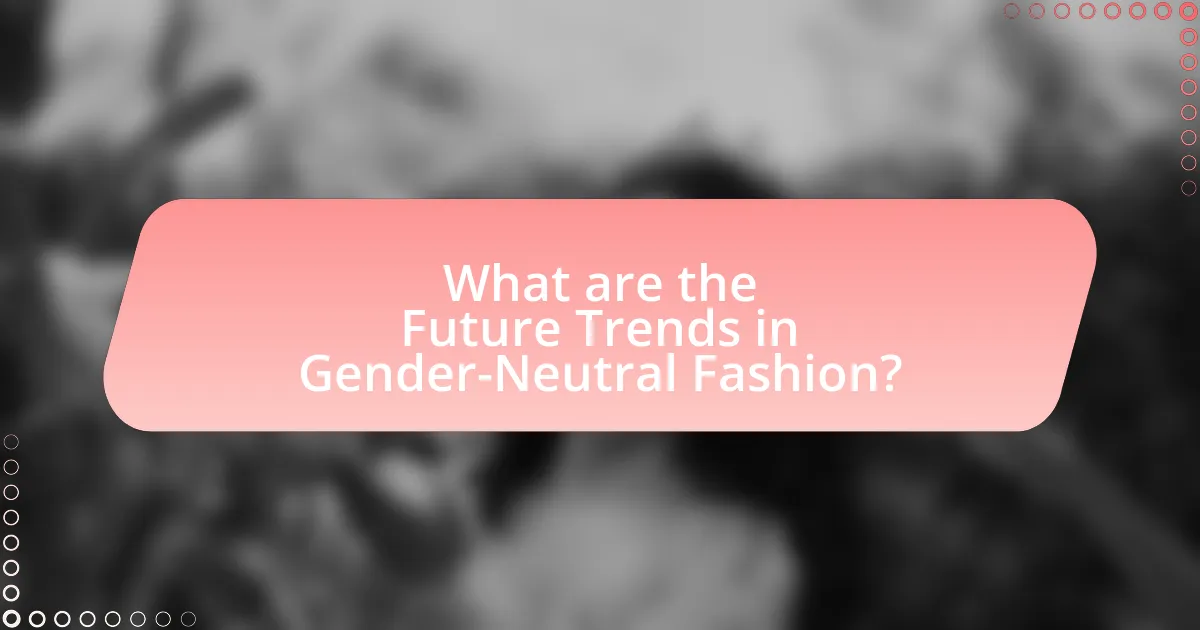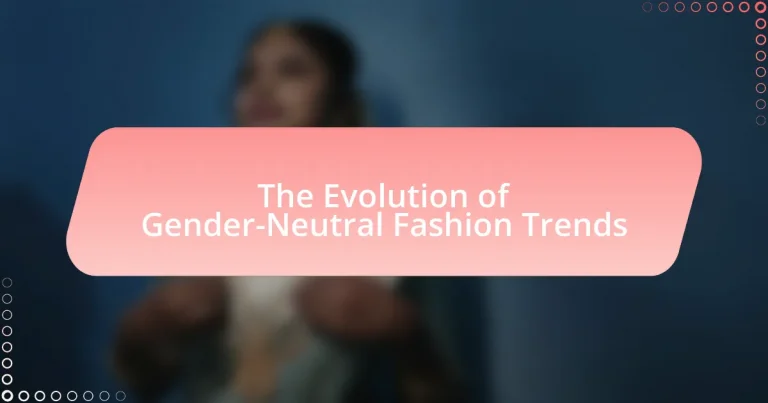The article focuses on the evolution of gender-neutral fashion trends, which are designed to be inclusive and accessible to individuals regardless of their gender identity. It explores the historical context of these trends, highlighting key movements such as feminism and rights that have influenced the shift towards unisex clothing. The article also examines the characteristics of gender-neutral fashion, including its emphasis on versatility, comfort, and the use of neutral color palettes. Additionally, it discusses the role of brands and influencers in promoting gender-neutral styles, the impact of societal attitudes on fashion, and future trends, including sustainability and technological innovations.

What are Gender-Neutral Fashion Trends?
Gender-neutral fashion trends are styles that are designed to be worn by individuals regardless of their gender identity, promoting inclusivity and breaking traditional gender norms in clothing. These trends often feature unisex silhouettes, neutral color palettes, and versatile designs that appeal to a broad audience. The rise of gender-neutral fashion has been influenced by cultural shifts towards acceptance of diverse gender identities and expressions, with brands like Telfar and Rad Hourani leading the way in creating collections that prioritize comfort and individuality over gender-specific styles.
How have gender-neutral fashion trends emerged over time?
Gender-neutral fashion trends have emerged over time as a response to evolving societal norms regarding gender identity and expression. Initially, in the early 20th century, fashion was strictly divided along gender lines, but movements such as the women’s liberation movement in the 1960s began to challenge these norms, leading to the introduction of unisex clothing. By the 1990s, designers like Jean-Paul Gaultier and brands such as Comme des Garçons popularized androgynous styles, further blurring gender distinctions in fashion. In recent years, the rise of social media and increased visibility of non-binary identities have accelerated the acceptance and demand for gender-neutral clothing, with major retailers like H&M and Zara launching unisex collections. This evolution reflects a broader cultural shift towards inclusivity and the rejection of traditional gender binaries in fashion.
What historical events influenced the rise of gender-neutral fashion?
The rise of gender-neutral fashion has been influenced by several historical events, notably the feminist movement of the 1960s and 1970s, which challenged traditional gender roles and promoted equality. This movement led to women adopting more masculine styles, such as trousers and tailored suits, which blurred the lines between gender-specific clothing. Additionally, the rights movement, particularly the Stonewall Riots in 1969, catalyzed a cultural shift towards acceptance of diverse gender identities and expressions, further encouraging designers to create unisex clothing. The emergence of androgynous models in the 1980s and 1990s, such as David Bowie and Grace Jones, also played a significant role in popularizing gender-neutral aesthetics in mainstream fashion. These events collectively contributed to the ongoing evolution of gender-neutral fashion trends.
How have societal attitudes towards gender and fashion evolved?
Societal attitudes towards gender and fashion have evolved significantly, shifting from rigid gender norms to a more fluid understanding of identity and expression. Historically, fashion was strictly divided along gender lines, with men and women adhering to distinct styles and expectations; for example, the 19th century emphasized corsets for women and tailored suits for men. However, the late 20th century saw the rise of gender-neutral fashion, influenced by movements such as feminism and rights, which challenged traditional gender roles. This shift is evidenced by the increasing popularity of unisex clothing lines and the acceptance of diverse gender expressions in mainstream fashion, as seen in brands like Telfar and gender-fluid collections from major retailers. The evolution reflects a broader societal recognition of gender as a spectrum rather than a binary, allowing individuals to express themselves beyond conventional fashion constraints.
Why is gender-neutral fashion important in today’s society?
Gender-neutral fashion is important in today’s society because it promotes inclusivity and challenges traditional gender norms. This fashion movement allows individuals to express their identity without the constraints of binary gender categories, fostering a sense of belonging for diverse gender identities. Research indicates that 62% of Gen Z consumers prefer brands that offer gender-neutral options, reflecting a significant cultural shift towards acceptance and representation in fashion. By embracing gender-neutral styles, the fashion industry not only caters to a broader audience but also contributes to the dismantling of stereotypes, ultimately leading to a more equitable society.
What impact does gender-neutral fashion have on identity expression?
Gender-neutral fashion significantly enhances identity expression by allowing individuals to choose clothing that aligns with their personal identity rather than conforming to traditional gender norms. This fashion movement promotes inclusivity and self-acceptance, enabling people to express their gender identity fluidly. Research indicates that gender-neutral clothing can reduce societal pressure and stigma associated with gender-specific attire, fostering a sense of belonging and authenticity among diverse gender identities. For instance, a study published in the Journal of Fashion Marketing and Management highlights that consumers who engage with gender-neutral fashion report higher levels of self-esteem and comfort in their identity expression.
How does gender-neutral fashion challenge traditional gender norms?
Gender-neutral fashion challenges traditional gender norms by promoting clothing that is not restricted by societal expectations of masculinity or femininity. This movement encourages individuals to express their identity through fashion without conforming to binary gender classifications, thereby dismantling stereotypes associated with gendered clothing. For instance, brands like Telfar and Rad Hourani have gained recognition for their unisex designs, which appeal to a diverse audience and emphasize inclusivity. Research indicates that the rise of gender-neutral fashion reflects broader societal shifts towards acceptance of non-binary identities, as evidenced by increased visibility and representation in media and culture.

What are the Key Characteristics of Gender-Neutral Fashion?
Key characteristics of gender-neutral fashion include inclusivity, versatility, and a focus on comfort. Inclusivity is evident as gender-neutral fashion aims to eliminate traditional gender norms, allowing individuals to express themselves without the constraints of male or female categories. Versatility is highlighted through designs that can be worn by anyone, regardless of gender, often featuring unisex silhouettes and neutral color palettes. Comfort is prioritized in the choice of fabrics and fits, catering to a wide range of body types and personal preferences. These characteristics reflect a broader cultural shift towards acceptance and diversity in personal expression within the fashion industry.
How do materials and designs differ in gender-neutral fashion?
Materials and designs in gender-neutral fashion differ primarily in their inclusivity and versatility. Gender-neutral fashion often utilizes fabrics that are not traditionally associated with a specific gender, such as soft cottons, durable denims, and technical materials that offer comfort and functionality. Designs tend to favor relaxed silhouettes, unstructured shapes, and neutral color palettes, which allow for a broader range of body types and personal expressions. This approach contrasts with traditional gendered fashion, which typically emphasizes tailored fits and distinct color schemes aligned with societal gender norms. The shift towards gender-neutral fashion reflects a growing recognition of diverse identities and the desire for clothing that transcends binary classifications.
What types of fabrics are commonly used in gender-neutral clothing?
Commonly used fabrics in gender-neutral clothing include cotton, linen, jersey, and polyester. Cotton is favored for its breathability and comfort, making it suitable for various styles. Linen offers a lightweight and relaxed feel, ideal for casual wear. Jersey fabric provides stretch and flexibility, enhancing movement and comfort. Polyester is often used for its durability and ease of care, making it a practical choice for everyday garments. These fabrics collectively support the versatility and inclusivity that characterize gender-neutral fashion.
How do design elements reflect a gender-neutral approach?
Design elements reflect a gender-neutral approach by utilizing colors, shapes, and styles that are not traditionally associated with a specific gender. For instance, the use of muted color palettes, such as greys, whites, and earth tones, avoids reinforcing gender stereotypes often linked to brighter or more saturated colors. Additionally, clothing silhouettes that are loose-fitting and unstructured, rather than tailored or form-fitting, promote inclusivity by allowing for a range of body types and personal expressions. This approach is supported by the rise of brands like Telfar and Rad Hourani, which emphasize unisex designs, demonstrating a shift in consumer demand for fashion that transcends gender binaries.
What role do influencers and brands play in promoting gender-neutral fashion?
Influencers and brands play a crucial role in promoting gender-neutral fashion by shaping public perception and driving consumer behavior. Influencers leverage their platforms to showcase gender-neutral styles, often reaching diverse audiences and normalizing the concept of fashion beyond traditional gender binaries. Brands, on the other hand, contribute by designing and marketing collections that explicitly cater to gender-neutral aesthetics, thus validating and supporting the movement. For instance, major brands like Gucci and Telfar have launched unisex lines, which not only reflect changing societal norms but also influence market trends, as evidenced by a 2021 report from McKinsey & Company indicating a growing demand for gender-inclusive clothing among consumers.
Which brands are leading the way in gender-neutral fashion trends?
Brands leading the way in gender-neutral fashion trends include Telfar, Rad Hourani, and Gender Free World. Telfar is known for its inclusive designs and unisex bags, which have gained significant popularity and recognition in the fashion industry. Rad Hourani has been a pioneer in unisex clothing, emphasizing a blend of masculine and feminine aesthetics in its collections. Gender Free World focuses on creating clothing that transcends traditional gender norms, promoting a more inclusive approach to fashion. These brands exemplify the shift towards gender-neutral fashion by challenging conventional gender binaries and offering versatile clothing options.
How do social media influencers impact the perception of gender-neutral fashion?
Social media influencers significantly shape the perception of gender-neutral fashion by promoting inclusivity and challenging traditional gender norms. Their platforms allow them to showcase diverse styles that blend elements from both masculine and feminine aesthetics, thereby normalizing gender-neutral clothing choices. For instance, influencers like Jaden Smith and Emma Chamberlain have garnered substantial followings by wearing and endorsing brands that prioritize gender-neutral designs, leading to increased visibility and acceptance of such fashion. This visibility is supported by research indicating that 70% of consumers are influenced by social media when making fashion choices, highlighting the powerful role influencers play in shaping public perception and trends in gender-neutral fashion.

What are the Future Trends in Gender-Neutral Fashion?
Future trends in gender-neutral fashion include increased inclusivity, sustainability, and the rise of unisex collections. Brands are shifting towards designs that cater to all genders, reflecting a growing societal acceptance of diverse gender identities. The global market for gender-neutral clothing is projected to grow significantly, with a report by Allied Market Research estimating it will reach $400 billion by 2025. Additionally, sustainable practices are becoming integral, as consumers demand eco-friendly materials and ethical production methods. This evolution is supported by the increasing visibility of gender-fluid influencers and the mainstreaming of gender-neutral fashion in major retail outlets.
How is technology shaping the future of gender-neutral fashion?
Technology is shaping the future of gender-neutral fashion by enabling innovative design processes, enhancing customization, and promoting inclusivity through digital platforms. Advanced technologies such as 3D printing allow designers to create versatile clothing that can be easily adapted for various body types, breaking traditional gender norms in fashion. Additionally, artificial intelligence and data analytics help brands understand consumer preferences, leading to more inclusive collections that cater to diverse gender identities. For instance, companies like Unisex and Telfar utilize technology to create unisex lines that resonate with a broader audience, reflecting a shift towards gender-neutrality in the industry.
What innovations are being introduced in gender-neutral clothing production?
Innovations in gender-neutral clothing production include the use of advanced fabric technologies, such as moisture-wicking and stretch materials, which enhance comfort and versatility for all body types. Additionally, brands are increasingly adopting inclusive sizing and unisex designs that prioritize fit over traditional gender norms. For instance, companies like Telfar and Rad Hourani have pioneered collections that feature adaptable silhouettes, allowing garments to be worn by anyone regardless of gender. These innovations reflect a growing trend towards sustainability and ethical production practices, with many brands utilizing recycled materials and eco-friendly manufacturing processes to appeal to a broader audience.
How might sustainability influence future gender-neutral fashion trends?
Sustainability will significantly influence future gender-neutral fashion trends by promoting eco-friendly materials and ethical production practices. As consumers increasingly prioritize environmental responsibility, brands will adapt by using sustainable fabrics like organic cotton and recycled polyester, which appeal to a broader audience regardless of gender. Additionally, the rise of circular fashion, which emphasizes recycling and upcycling, will encourage gender-neutral designs that are versatile and long-lasting, reducing waste. This shift is supported by a 2021 McKinsey report indicating that 67% of consumers consider sustainability when making fashion purchases, highlighting the demand for responsible fashion choices that transcend traditional gender norms.
What challenges does gender-neutral fashion face moving forward?
Gender-neutral fashion faces challenges such as market acceptance, consumer perception, and supply chain adaptation. Market acceptance is hindered by traditional gender norms that influence purchasing behaviors, as many consumers still prefer gender-specific clothing. Consumer perception poses a challenge, as some individuals may associate gender-neutral fashion with a lack of identity or style, limiting its appeal. Additionally, supply chains must adapt to produce versatile clothing that meets diverse consumer needs, which can complicate manufacturing processes and increase costs. These challenges must be addressed for gender-neutral fashion to gain broader traction in the retail landscape.
How do market perceptions affect the growth of gender-neutral fashion?
Market perceptions significantly influence the growth of gender-neutral fashion by shaping consumer demand and brand strategies. When consumers view gender-neutral fashion positively, it leads to increased sales and investment in such lines, as evidenced by a 2021 report from McKinsey & Company, which highlighted that 60% of consumers are more likely to purchase from brands that offer inclusive options. Additionally, as societal attitudes shift towards acceptance of diverse gender identities, brands that align with these perceptions can enhance their market presence and attract a broader customer base. This alignment not only drives sales but also encourages other brands to adopt gender-neutral practices, further propelling the trend’s growth.
What barriers exist for consumers in adopting gender-neutral fashion?
Barriers for consumers in adopting gender-neutral fashion include societal norms, lack of availability, and limited marketing. Societal norms often dictate traditional gender roles, making consumers hesitant to embrace styles that defy these expectations. Additionally, many retailers do not offer a wide range of gender-neutral options, limiting consumer choice. Marketing strategies frequently target specific gender demographics, which can alienate potential buyers interested in gender-neutral clothing. These factors collectively hinder the widespread acceptance and adoption of gender-neutral fashion among consumers.
What practical tips can consumers follow to embrace gender-neutral fashion?
Consumers can embrace gender-neutral fashion by selecting versatile clothing items that prioritize comfort and fit over traditional gender norms. This includes choosing oversized silhouettes, unisex styles, and neutral color palettes that can be worn by anyone regardless of gender. Additionally, consumers should explore brands that specifically focus on gender-neutral collections, as these often provide a wider range of options designed to be inclusive. Research indicates that the rise of gender-neutral fashion is driven by changing societal attitudes towards gender identity, with a 2021 study by McKinsey & Company highlighting that 60% of consumers are interested in brands that promote inclusivity.


